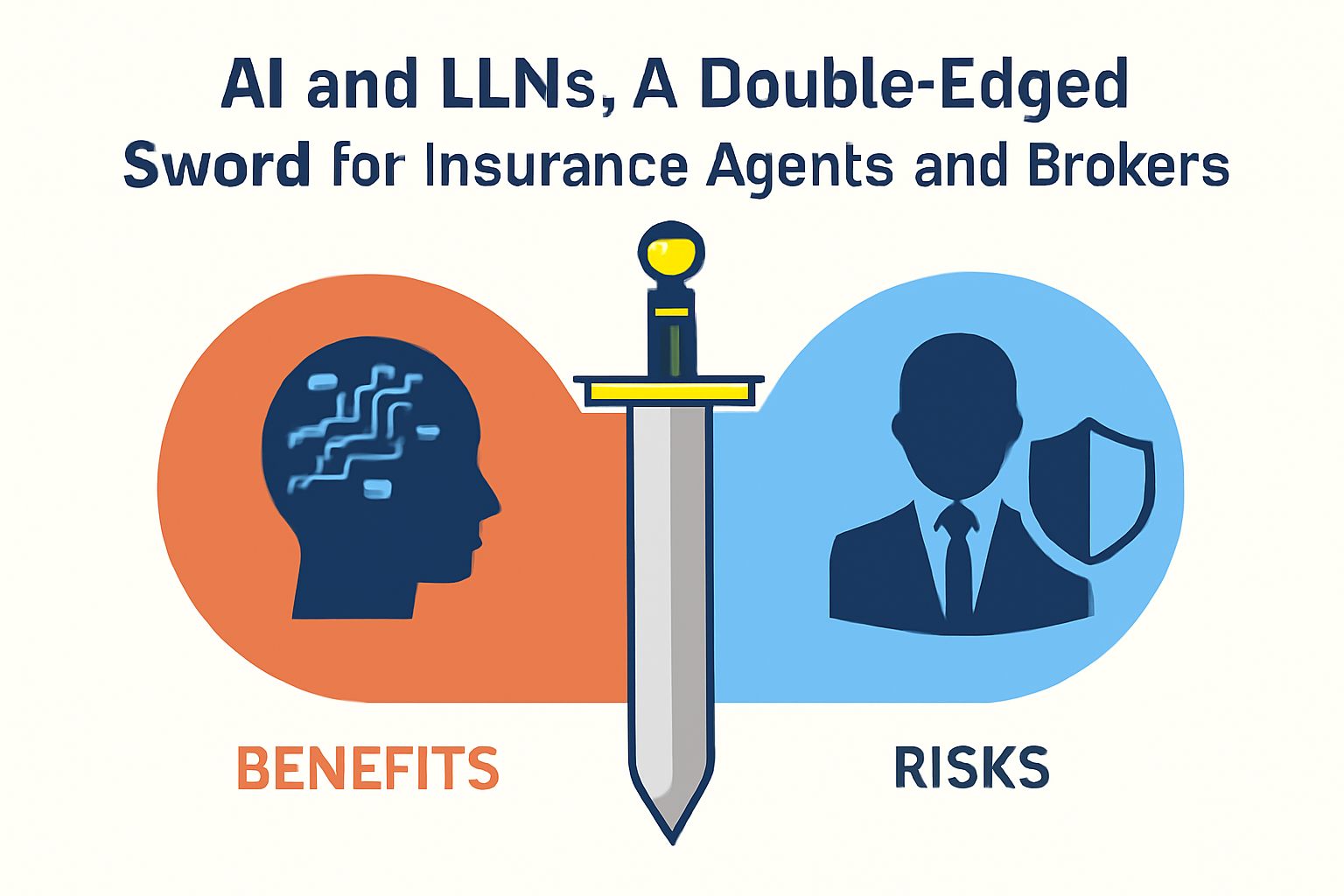In the rapidly evolving digital landscape, Artificial Intelligence (AI) and Large Language Models (LLMs) have become pivotal technologies, transforming industries across the globe. The insurance industry, traditionally known for its reliance on human expertise and careful decision-making, is no exception. As AI and LLMs are integrated into various aspects of the insurance process, they present both significant opportunities and challenges for insurance agents and brokers.
While AI promises to streamline operations, enhance customer experiences, and improve decision-making, it also raises concerns about job displacement, data privacy, and the loss of the personal touch that clients often seek in their insurance relationships. For agents and brokers, navigating these benefits and risks requires careful consideration. Let’s explore how AI and LLMs are shaping the future of the insurance industry, highlighting both the advantages and the potential pitfalls.
The Rise of AI and LLMs in the Insurance Industry
Artificial intelligence has already begun to impact many sectors of the economy, and the insurance industry is no different. From underwriting to claims processing and customer service, AI tools have the potential to make significant improvements in operational efficiency. One of the most notable applications of AI in insurance is the use of LLMs—complex algorithms that can understand and generate human language. These models, like OpenAI’s GPT-4 or Google’s LaMDA, have the ability to process vast amounts of data, generate insights, and even interact with customers in a conversational manner.
AI in Underwriting and Risk Assessment
Underwriting, the process by which insurers evaluate the risks associated with insuring a person or entity, has traditionally been a complex, data-intensive task. With AI, this process can be significantly accelerated and made more accurate. AI systems can analyze vast amounts of data—ranging from medical records to driving habits—and assess risks with higher precision. LLMs also help in interpreting unstructured data, such as written reports or claim notes, which often contain valuable insights that human underwriters might overlook.
However, the reliance on AI in underwriting also has its downsides. The risk of algorithmic bias is a major concern. If an AI system is trained on biased historical data, it could perpetuate those biases, leading to unfair outcomes. For example, an AI system might unfairly classify certain demographic groups as higher risk due to biased training data, which could result in higher premiums or denied claims for individuals from these groups. Brokers and agents will need to ensure that AI tools are transparent and fair to avoid such issues.
Claims Processing and Fraud Detection
Claims processing is another area where AI has been making waves. The automation of claims management allows for faster processing times, reducing the administrative burden on insurance companies. AI algorithms can quickly assess claim validity by cross-referencing claims with databases, analyzing the details provided by policyholders, and detecting inconsistencies that may indicate fraudulent behavior.
LLMs, in particular, have the potential to improve customer service during the claims process. By utilizing AI-powered chatbots, insurers can provide real-time assistance to policyholders, guiding them through the claims process and answering questions without the need for human intervention. This can result in faster resolutions and greater satisfaction for customers.
However, the use of AI in claims processing also presents a challenge for insurance agents and brokers. While automation can streamline operations, it also reduces the need for human involvement in claims handling. As a result, agents and brokers may find their roles diminished, especially in cases where they used to serve as intermediaries between the insurer and the client. Additionally, AI-powered fraud detection systems are not foolproof, and they may occasionally flag legitimate claims as fraudulent, leading to customer frustration and loss of trust.
Customer Service and Personalization
In terms of customer service, AI and LLMs have the potential to revolutionize the way insurers interact with policyholders. By using AI-driven chatbots and virtual assistants, insurance companies can provide 24/7 support, answering customer queries, processing claims, and even offering policy recommendations. LLMs enhance these interactions by enabling more human-like conversations, improving the customer experience.
Moreover, AI can help brokers and agents offer more personalized services. By analyzing customer data, AI systems can identify trends and preferences, allowing agents to recommend products that better match individual needs. For instance, an AI tool might analyze a client’s driving history, health records, and lifestyle to suggest a tailored car insurance policy or health insurance plan. This personalization can help agents and brokers build stronger relationships with clients and improve sales conversions.
While these benefits are substantial, they come with their own set of challenges. For one, there is a growing concern about the erosion of human relationships in the industry. Insurance, by nature, is a highly personal service, and many clients rely on agents and brokers for advice, support, and understanding. The rise of AI-driven customer service might lead to a situation where clients feel alienated by automated systems, especially when complex or sensitive issues arise that require human empathy and judgment.
The Double-Edged Sword: Opportunities vs. Risks
As we can see, AI and LLMs present both exciting opportunities and significant risks for insurance agents and brokers. Let’s examine both sides of the coin.
The Opportunities: Efficiency, Innovation, and Personalization
- Increased Efficiency: One of the most significant advantages of AI and LLMs is their ability to automate routine tasks, freeing up time for insurance agents and brokers to focus on more complex and value-added activities. Tasks such as underwriting, claims processing, and customer support can be automated to improve efficiency, reduce costs, and minimize human error.
- Improved Customer Insights: AI systems can analyze vast amounts of customer data to uncover valuable insights that can inform sales strategies and improve customer satisfaction. This allows agents and brokers to offer more personalized services, leading to better customer retention and higher conversion rates.
- Enhanced Decision-Making: With the ability to process large amounts of data in real-time, AI-powered tools can assist insurance professionals in making more informed decisions. Whether it’s determining the risk of insuring a particular individual or evaluating the validity of a claim, AI can offer valuable insights that help brokers and agents make smarter choices.
- Cost Reduction: By automating routine tasks and streamlining operations, insurance companies can lower their operational costs. This cost reduction can be passed on to clients in the form of lower premiums, which could help brokers remain competitive in an increasingly crowded market.
The Risks: Job Displacement, Bias, and Loss of Personal Touch
- Job Displacement: One of the biggest concerns surrounding AI and LLMs is the potential for job displacement. As AI automates routine tasks and enhances operational efficiency, many roles within the insurance industry—especially those traditionally performed by agents and brokers—may become redundant. While AI is unlikely to fully replace human agents, it could significantly reduce the demand for human involvement in certain aspects of the business.
- Algorithmic Bias: AI systems are only as good as the data they are trained on. If an AI model is trained on biased data, it can perpetuate those biases in its decision-making process. For example, an AI system used in underwriting might unfairly disadvantage certain groups of people based on factors such as race, gender, or socioeconomic status. Insurance agents and brokers must be vigilant about the potential for bias in AI tools and work to mitigate its impact.
- Loss of Human Element: Insurance is a service-based industry, and many customers value the personal touch that brokers and agents provide. The introduction of AI-powered customer service systems, while efficient, may result in clients feeling disconnected or dissatisfied with the lack of human interaction. Insurance agents and brokers will need to find a balance between leveraging AI to improve efficiency and maintaining the personal relationships that are so important in the industry.
- Data Privacy Concerns: With AI systems processing vast amounts of customer data, there are significant concerns about data privacy and security. Insurance companies must ensure that they are following proper data protection protocols and are transparent with their customers about how their data is being used. The potential for data breaches or misuse of personal information is a critical issue that agents and brokers must address.
The Future of AI and LLMs in Insurance: Striking a Balance
As AI and LLMs continue to evolve, insurance agents and brokers will need to adapt to the changing landscape. Embracing AI as a tool for enhancing operational efficiency, improving customer service, and offering personalized solutions can provide a competitive edge in an increasingly digital world. However, it is crucial that agents and brokers remain mindful of the ethical considerations surrounding AI, including issues of bias, privacy, and job displacement.
To thrive in this new era, insurance professionals will need to strike a balance between leveraging AI to enhance their offerings and maintaining the human touch that clients value. AI should be viewed not as a replacement for human expertise, but as a tool to augment the capabilities of agents and brokers, allowing them to focus on more complex tasks and provide better value to their clients.
In the end, AI and LLMs represent a double-edged sword for insurance agents and brokers. While they offer immense potential for innovation and efficiency, they also present risks that must be carefully managed. By embracing the opportunities while mitigating the challenges, insurance professionals can position themselves for success in a rapidly evolving industry.




4 comments
Как добиться гармонии в доме с помощью мебели высшего качества.
Мебель премиум-класса https://byfurniture.by .
credited his charitable spirit to his education https://en.wikipedia.org/wiki/Chuck_Feeney/ .
Технологии для роста трафика, для быстрого успеха.
Прогон сайта GSA https://www.kwork.ru/links/41629912/seo-pushka-dlya-sayta-mnogourovnevaya-piramida-ssylok-pod-klyuch .
Лучшие предложения электромонтажных услуг в Москве
Электрик на дом http://www.elektrik-master-msk.ru/ .